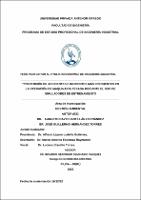Prevención de accidentes e incidentes más frecuentes en la operación de maquinaria pesada mediante el uso de simuladores de entrenamiento

Ver/
Descargar
(application/pdf: 4.896Mb)
(application/pdf: 4.896Mb)
Fecha
2023Autor(es)
Santillan Hernandez, Augusto David
Hernández Torres, José Guillermo
Metadatos
Mostrar el registro completo del ítemResumen
La fundamentación de este proyecto de tesis se encuentra orientado a la
prevención de accidentes e incidentes más recurrentes en la operación de
maquinaria pesada haciendo uso de simuladores de preentrenamiento.
Siendo la finalidad de estos últimos, formar operarios competitivos y
comprometidos con la preservación de la vida, los recursos de la empresa y el
medio ambiente, así mismo la seguridad de los conductores y de la maquinaria
que operan.
Se procedió a capacitar teóricamente al estudiante respecto a las normativas de
seguridad, luego se hizo uso de simuladores Simlog con los cuales se instruyó a
una muestra de estudiantes por conveniencia, obteniéndose como resultados las
etapas inicial con 90% de incidentes, en la etapa intermedia las incidencias
fueron del 40% y en la etapa final estas no superaron el 10%.en el uso del
simulador. Por otro lado, se determinaron los costos mínimos al no utilizar
simulador que ascienden a 3000 soles.
Así mismo, se capacitó al estudiante, en el entrenamiento con maquinas reales
en un periodo de 20 horas, obteniéndose los resultados de cero accidentes e
incidentes The foundation of this thesis project is oriented to the prevention of
accidents and more recurring incidents in the operation of heavy
machinery using pre-training simulators.
Being the purpose of the latter, to train competitive operators and
committed to the preservation of life, company resources and the
environment, as well as the safety of drivers and the machinery they
operate.
The student was theoretically trained regarding safety regulations, then
Simlog simulators were used with which a sample of students was
instructed for convenience, obtaining as results the initial stages with 90%
of incidents, in the intermediate stage the incidences were 40% and in the
final stage these did not exceed 10% in the use of the simulator. On the
other hand, the minimum costs were determined by not using a simulator
that amounted to 3000 soles.
Likewise, the student was trained in training with real machines in a period
of 20 hours, obtaining the results of zero accidents and incidents
Palabras clave
Colecciones
- Ingeniería Industrial [356]

